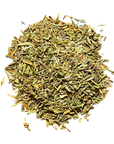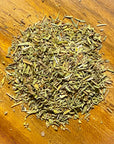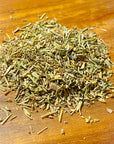


Thyme
Botanical name: Thymus vulgaris
^Organic
Thymus vulgaris, commonly known as common thyme, is a perennial herb belonging to the Lamiaceae family. This aromatic plant is native to the Mediterranean region and thrives in well-drained, sunny locations, making it a popular choice in gardens worldwide. Common thyme is characterized by its small, oval leaves and tiny purple flowers, which bloom in the summer, adding beauty and fragrance to landscapes.
In culinary uses, thyme is highly valued for its robust, earthy flavor, often used to season a variety of dishes, including meats, vegetables, and soups. The leaves can be used fresh or dried, and they impart a warm, savory taste that enhances the overall flavor profile of meals. In herbal medicine, thyme has been traditionally recognized for its potential benefits in supporting respiratory health and digestion, often enjoyed as a soothing tea.*
*These statements have not been evaluated by the Food and Drug Administration. This product is not intended to diagnose, treat, cure, or prevent any disease. For educational purposes only.



